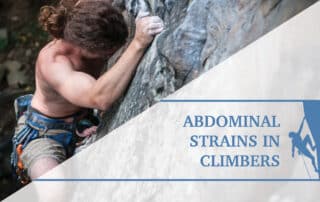Ulnar Nerve Entrapment In Rock Climbers
You’ve made huge strides in your climbing ability since you touched that first hold a couple of years ago. Now, you’ve got your sights on the next grade, but you’ve hit a plateau. You decide to train 5-6 days a week to get stronger for climbing.
Abdominal Strains In Rock Climbers
Muscle strains result from a sudden contracture of lengthened muscle fibers that causes them to rupture. In regard to climbing, abdominal strength, flexibility, and neuromuscular coordination is critical. Impaired abdominal function may result in injury.
Brachialis Tendinopathy in Climbers
You’re noticing improvements in your climbing, but you are starting to feel a bit broken down and are developing some mild pain in the front of your elbow that worsens after a long week of training and climbing. You even notice a bit of swelling in your elbow. What should you do?
Thoracic Outlet Syndrome in Climbers
Thoracic Outlet Syndrome is a diagnosis of exclusion, meaning there can be other causes of pain and numbness, such as cervical radiculopathy or other nerve entrapments, that may not be due to true TOS. Learn more about how to diagnose and treat the condition.
Rock Climbing Finger Tenosynovitis
Tenosynovitis, or inflammation of the finger flexor tendon sheath (synovium), is a common overuse syndrome that climbers may experience. There are 2 musculotendinous units that could be involved, the flexor digitorum superficialis (FDS) and flexor digitorum profundus (FDP).
Biceps Tendon Rupture in Climbers
Although biceps tendon ruptures rare among climbing athletes, this article provides both climbers and clinicians a guideline to identify the injury if it occurs. Additionally, it provides a guideline to help understand the course of conservative rehab following surgical intervention of a distal biceps tendon rupture.






